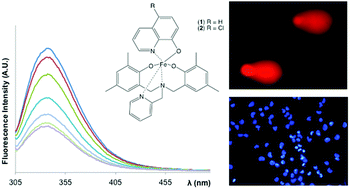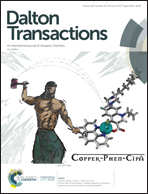New ternary iron(iii) aminobisphenolate hydroxyquinoline complexes as potential therapeutic agents†
Abstract
In the quest for therapeutic iron-based metallodrugs, two new mixed-ligand iron(III) complexes bearing the tripodal aminobisphenolate ligand N,N-bis(3,5-dimethyl-2-hydroxybenzyl)-N-(2-pyridylmethyl)amine (H2L) and hydroxyquinoline co-ligands, 8-hydroxyquinoline (8HQ) or 5-chloro-8-hydroxyquinoline (Cl8HQ), are synthesized, fully characterized and formulated as [Fe(L)(8HQ)] (1) and [Fe(L)(Cl8HQ)] (2), respectively. These high-spin Fe(III) complexes are stable in aqueous solution in the presence of equimolar amounts of Bovine Serum Albumin (BSA), which indicates a likely binding interaction with the protein. In fact, binding constant log values at pH 7.4 for HSA of 5.08 and 6.35 were obtained for 1 and 2, respectively. Compounds 1 and 2 are cytotoxic against both human triple-negative breast adenocarcinoma (MDA-MB-231) and human cervical carcinoma (HeLa) cancer cells, and the activity is significantly improved by inclusion of the co-ligands 8HQ and Cl8HQ to the precursor complex Fe(L). Moreover, 1 and 2 are more active than 8HQ and Cl8HQ, particularly at lower incubation times tested, 24 and 48 h. Cells treated with the complexes display typical features of apoptosis as assessed by cellular morphology, DNA condensation and TUNEL analysis. COMET assays show that both drug candidates induce genomic damage in both cell lines. The complexes exhibit DNA cleavage activity and DNA damage that may be related to their ability to generate ROS. Overall, data supports that 1 and 2 are both active anticancer drug candidates within the low micromolar range. This is particularly interesting in the case of the breast MDA-MB-231 line, a model for triple-negative breast cancer that is an aggressive form of breast cancer, highly invasive and with limited treatment options and very poor prognosis. Furthermore, both complexes exhibited good anti-Mycobacterium tuberculosis activity, suggesting that 1 and 2 might have a wide spectrum of biological activity and justify further research.

- This article is part of the themed collection: Nitrogen Ligands


 Please wait while we load your content...
Please wait while we load your content...